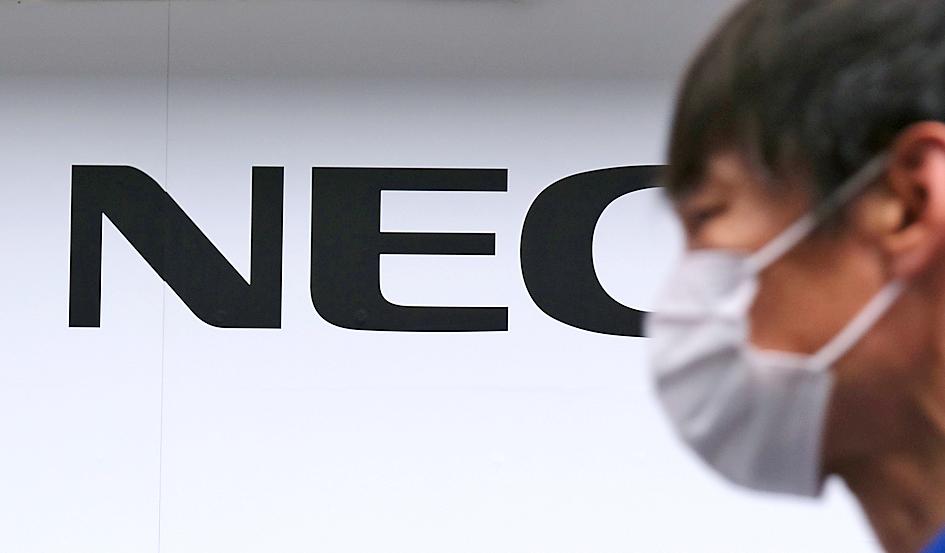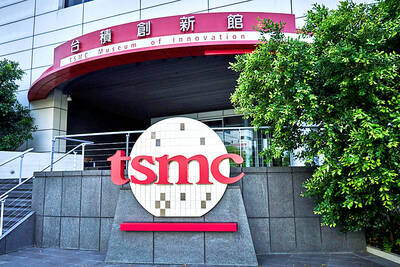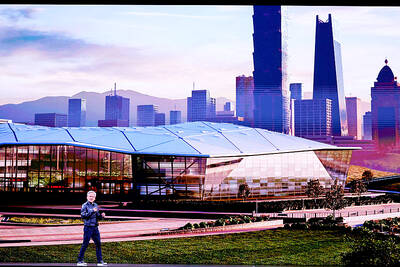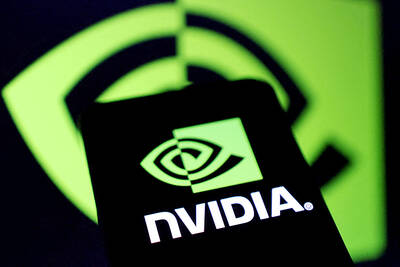With growing pressure to keep China’s Huawei Technologies Co (華為) out of 5G network development, it could be time for firms like Japan’s NEC Corp and South Korea’s Samsung Electronics Co to shine, analysts have said.
Washington has already pledged to cut the firm out of the most sensitive “core” elements of 5G that access personal data, and is now reportedly pushing for plans to end Huawei’s involvement in Britain’s 5G infrastructure by 2023.
Excluding Huawei is not without challenges, because there are currently only two alternatives in Europe for 5G equipment such as antennas and relay masts: Finland’s Nokia Oyj and Sweden’s Ericsson AB.

Photo: AFP
Britain has encouraged Washington to form a club of 10 democratic nations that could develop its own 5G technology, but there has been little movement so far.
“The vast majority of the commercial networks sold in the world come from the big three,” BearingPoint head of telecoms Sylvain Chevallier said, referring to Huawei, Nokia and Ericsson.
“But a world of three is not good for operators, and if it goes down to two it will be worse still,” he said.
That leaves a tempting potential opening for firms like Samsung and NEC, but building a successful 5G network is no simple task.
That is a lesson Samsung has already learned. Despite being a major player in 3G, it found itself unable to compete with the big three on 4G and struggled to win commercial contracts.
“This has been a challenge for Samsung,” said Daryl Schoolar, a mobile technology specialist at consulting group Omdia.
In building its 5G network, Samsung has so far focused on North America and parts of the Asia-Pacific region.
“So while operators may feel uncertain about Samsung Networks, they are much further along in the process of being a global presence than NEC,” Schoolar said.
NEC does have some advantages, including a partnership in Japan with mobile operator Rakuten Inc.
The firms have already cooperated on a 4G network and are jointly developing a 5G system.
The Japanese firm is also a leader on undersea cables, fiber optic networks and — thanks to its affiliate Netcracker Technology Corp — logistics management software.
“Netcracker has a strong presence with operators in Europe, which could be a real entry point for NEC,” said Stephane Teral, chief telecoms analyst at LightCounting, a market research firm.
NEC is tight-lipped about its contracts for mobile networks, saying only that it is holding feasibility demonstrations for “a number of customers and we are engaged in commercial discussions with others.”
Britain’s government has reportedly asked both NEC and Samsung to take part in demonstrations as it looks to diversify its 5G options.
On Thursday, NEC announced a tie-up with Japanese operator NTT Docomo Inc, intended in part to speed up the development of a 5G network.
Samsung and NEC joined forces two years ago and have launched a joint marketing team to offer 5G products to European and Asian markets.
Still, the path ahead would be tough, Schoolar said.
“I think it’s a major challenge for NEC. It requires more than radios, it requires investing in people who can do system integration, sales, customer support, network design and engineering,” he said.
“Plus, NEC will need to build operator trust that they will be there to support them in five to 10 years as those 5G networks evolve,” he added.
Washington has backed the use of nonproprietary technology such as Open RAN in 5G development, hoping it would provide an entry point for US firms.
Such a move would open up opportunities for NEC, allowing them to “create an economic model that would shake up traditional equipment manufacturers,” Chevallier said.

SEEKING CLARITY: Washington should not adopt measures that create uncertainties for ‘existing semiconductor investments,’ TSMC said referring to its US$165 billion in the US Taiwan Semiconductor Manufacturing Co (TSMC, 台積電) told the US that any future tariffs on Taiwanese semiconductors could reduce demand for chips and derail its pledge to increase its investment in Arizona. “New import restrictions could jeopardize current US leadership in the competitive technology industry and create uncertainties for many committed semiconductor capital projects in the US, including TSMC Arizona’s significant investment plan in Phoenix,” the chipmaker wrote in a letter to the US Department of Commerce. TSMC issued the warning in response to a solicitation for comments by the department on a possible tariff on semiconductor imports by US President Donald Trump’s

The government has launched a three-pronged strategy to attract local and international talent, aiming to position Taiwan as a new global hub following Nvidia Corp’s announcement that it has chosen Taipei as the site of its Taiwan headquarters. Nvidia cofounder and CEO Jensen Huang (黃仁勳) on Monday last week announced during his keynote speech at the Computex trade show in Taipei that the Nvidia Constellation, the company’s planned Taiwan headquarters, would be located in the Beitou-Shilin Technology Park (北投士林科技園區) in Taipei. Huang’s decision to establish a base in Taiwan is “primarily due to Taiwan’s talent pool and its strength in the semiconductor

An earnings report from semiconductor giant and artificial intelligence (AI) bellwether Nvidia Corp takes center stage for Wall Street this week, as stocks hit a speed bump of worries over US federal deficits driving up Treasury yields. US equities pulled back last week after a torrid rally, as investors turned their attention to tax and spending legislation poised to swell the US government’s US$36 trillion in debt. Long-dated US Treasury yields rose amid the fiscal worries, with the 30-year yield topping 5 percent and hitting its highest level since late 2023. Stocks were dealt another blow on Friday when US President Donald

UNCERTAINTY: Investors remain worried that trade negotiations with Washington could go poorly, given Trump’s inconsistency on tariffs in his second term, experts said The consumer confidence index this month fell for a ninth consecutive month to its lowest level in 13 months, as global trade uncertainties and tariff risks cloud Taiwan’s economic outlook, a survey released yesterday by National Central University found. The biggest decline came from the timing for stock investments, which plunged 11.82 points to 26.82, underscoring bleak investor confidence, it said. “Although the TAIEX reclaimed the 21,000-point mark after the US and China agreed to bury the hatchet for 90 days, investors remain worried that the situation would turn sour later,” said Dachrahn Wu (吳大任), director of the university’s Research Center for